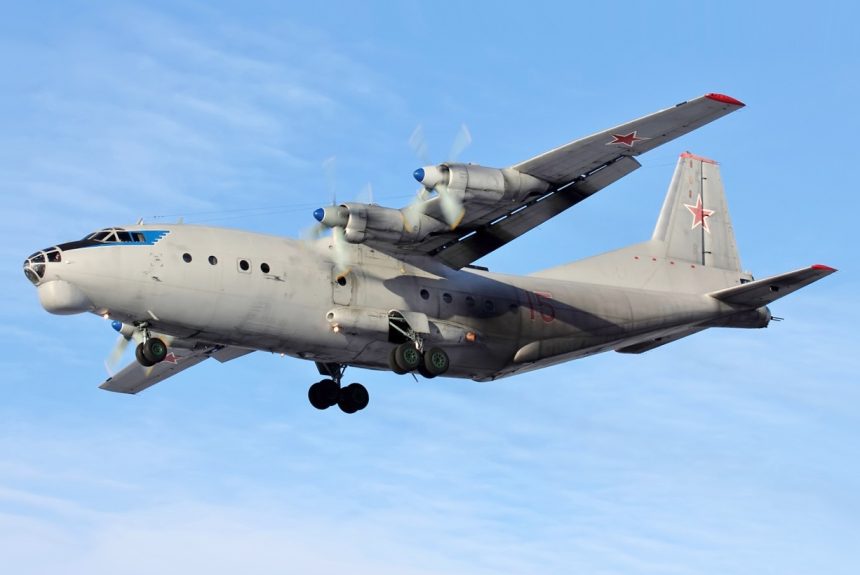On this day in aviation history, December 16, 1957, the Soviet firm Antonov made the first flight of a military transport that would be as vital to the combat operations of the Soviet Air Force as the Lockheed C-130 Hercules has been for the US Air Force. Much like its American counterpart, the Antonov An-12 “Cub” has seen widespread service in war and peace and remains in service around the world today in both civilian and military capacities.
The An-12 was the product of the Soviet design bureau Antonov, headed by its namesake, the designer Oleg Antonov. In the Soviet Union, the central government established design bureaus to develop aircraft for civil and military purposes, and appointed designers and engineers to lead them. By the mid 1950s, the Antonov Design Bureau had seen success with the An-2 biplane transport, whose antiquated looks belied its short takeoff and landing (STOL) capabilities, and the bureau had been relocated from Novosibirsk in southern Russia to Kiev (Kyiv in Ukrainian), then the capital of the Ukrainian Soviet Socialist Republic (Ukrainian SSR). During the mid 1950s, Antonov had built the Soviet Union’s first turboprop transport, the twin engine An-8 and had built a four-engine turboprop passenger transport, the An-10 Ukraina (Ukraine). During this time, it was reported that the Soviet General Secretary, Nikita Khrushchev, made his first state visit to the Antonov design bureau, and during his visit, he asked Antonov to build a larger version of the An-8 to compete with foreign designs for military turboprop transports. The result was the Antonov An-12, which was powered by four Ivchenko AI-20 turboprop engines. The first prototype, serial number 7900101, was flown from the State Aircraft Factory near the Siberian city of Irkutsk. The flight crew was led by Hero of the Soviet Union Yakov Vernikov, a WWII fighter ace turned test pilot for the Gromov Flight Research Institute. In 1959, the first An-12s were accepted into operational service with Soviet Air Force units, and NATO intelligence officials gave it the reporting name “Cub.”
In total, three state-run aircraft factories in the Russian Soviet Federative Socialist Republic (RSFSR) would be responsible for the construction of all 1,248 Soviet-built examples in Irkutsk, Voronezh, and Tashkent between 1957 and 1972. The Antonov An-12 could carry 100 fully equipped paratroopers or up to 20,000 kg (44,000 lbs.) of cargo and was flown by a crew of five (two pilots, flight engineer, navigator, radio operator). Some examples also carried a tail gunner, who controlled a pair of Nudelman-Rikhter NR-23 23mm cannons. Other aircraft served as electronic warfare planes with countermeasure equipment, crew trainers, VIP transports, radiation reconnaissance, aerial refueling tankers, and even as an airborne accident investigation laboratory.
The An-12 “Cub” would play a key role in Soviet deployments during the Cold War. In 1968, Cubs were involved in supplying troops and equipment of the Warsaw Pact to suppress the Prague Spring protests in Czechoslovakia, and in foreign service they would be involved in supporting operations during the Indo-Pakistani War of 1971, and the Angolan Civil War, but were extensively used during the Soviet Afghan War during 1980s, where the lack of local infrastructure in Afghanistan would see An-12s deliver supplies to Soviet forces at airbases that were more difficult for other transports to access. It was also in Afghanistan that the An-12 acquired the nickname of “Black Tulip,” as the An-12s were given the solemn task of returning the bodies of Soviet soldiers killed in action back to the USSR, their cargo bays full of “Cargo 200,” a term that has transcended Russian and former Soviet military circles into the wider popular lexicon of the former USSR countries. After the collapse of the Soviet Union, Antonov An-12s continued their service in both civil and military capacities in the former Soviet Union.
As the An-12 began to be adopted by the Soviet Air Force, the aircraft also received attention from Communist China, which purchased several examples from the Soviet Union and a license to build the aircraft. However, the Sino-Soviet Spit, caused in part due to ideological differences stemming from the political philosophies of Mao Zedong and Nikita Khrushchev, saw the People’s Republic of China place greater emphasis on building their military and industrial strength without assistance from the USSR, but not before adapting Soviet designs such as the An-12 for their own proposes. As such, the newly founded Shaanxi Aircraft Corporation built a Chinese version of the An-12 that would become known as the Shaanxi Y-8, which was first flown in 1974. The Y-8 also led to the development of the KJ-200 early warning aircraft and the improved Shaanxi Y-9 transport, which remain in service today.
Throughout its service life as a military and civilian transport, the An-12 has been flown and maintained in countries such as Algeria, Angola, Armenia, Afghanistan, Bangladesh, Bulgaria, Chad, China, Czechoslovakia (whose examples were then split between the Czech Republic and Slovakia), Egypt, France, Georgia, Guinea, Ghana, India, Indonesia, Iraq, Jordan, Kazakhstan, Mongolia, Myanmar, Nigeria, the Philippines, Poland, Russia, Serbia, South Yemen, the Soviet Union, Sudan, Syria, Tanzania, Thailand, Turkmenistan, Ukraine, Uzbekistan, and Yugoslavia. Today, the aircraft remains in operational service with the armed forces of Angola, Chad, Ethiopia, Kazakhstan, Myanmar, Nigeria, Russia, Sudan, and Uzbekistan, and is flown by companies in Armenia, Belarus, Russia, Thailand, and Ukraine, primarily for cargo flights. However, Antonov, which would become the Soviet Union’s biggest firm specializing in building transport aircraft, would go on to build further types of civilian and military transports, culminating in the An-124 Ruslan and the massive An-225 Myria, which was destroyed by Russian forces during the Battle of Antonov/Hostomel Airport in 2022.
Today in Aviation History is a series highlighting the achievements, innovations, and milestones that have shaped the skies. All the previous anniversaries are available HERE









































